ABS FIAT STRADA 2012 Owner handbook (in English)
[x] Cancel search | Manufacturer: FIAT, Model Year: 2012, Model line: STRADA, Model: FIAT STRADA 2012Pages: 187, PDF Size: 8.06 MB
Page 45 of 187
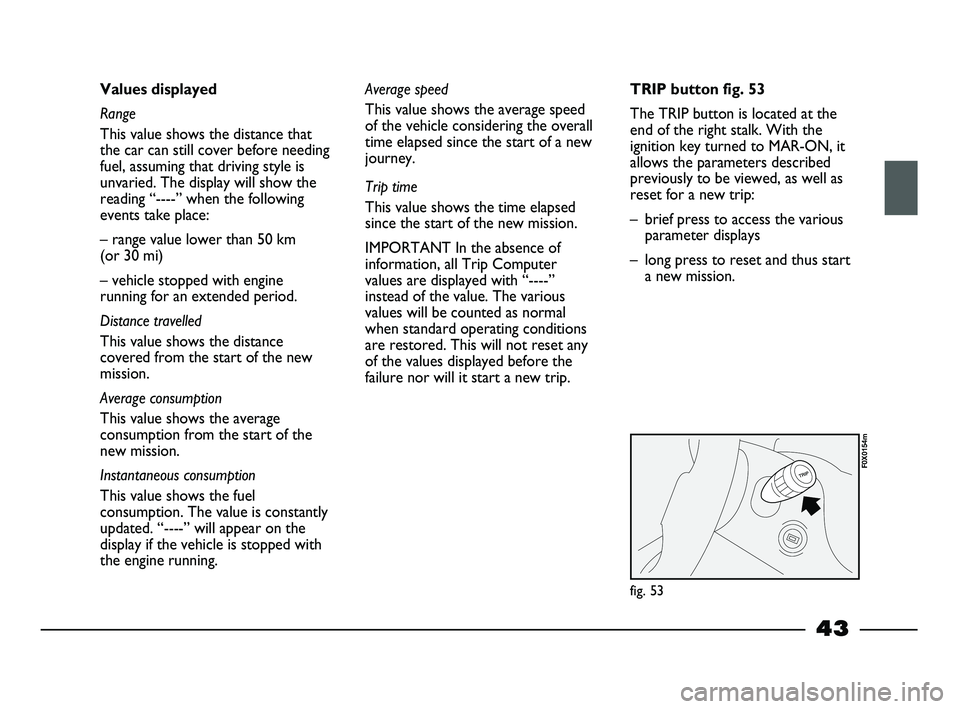
43
Values displayed
Range
This value shows the distance that
the car can still cover before needing
fuel, assuming that driving style is
unvaried. The display will show the
reading “----” when the following
events take place:
– range value lower than 50 km
(or 30 mi)
– vehicle stopped with engine
running for an extended period.
Distance travelled
This value shows the distance
covered from the start of the new
mission.
Average consumption
This value shows the average
consumption from the start of the
new mission.
Instantaneous consumption
This value shows the fuel
consumption. The value is constantly
updated. “----” will appear on the
display if the vehicle is stopped with
the engine running.Average speed
This value shows the average speed
of the vehicle considering the overall
time elapsed since the start of a new
journey.
Trip time
This value shows the time elapsed
since the start of the new mission.
IMPORTANT In the absence of
information, all Trip Computer
values are displayed with “----”
instead of the value. The various
values will be counted as normal
when standard operating conditions
are restored. This will not reset any
of the values displayed before the
failure nor will it start a new trip.TRIP button fig. 53
The TRIP button is located at the
end of the right stalk. With the
ignition key turned to MAR-ON, it
allows the parameters described
previously to be viewed, as well as
reset for a new trip:
– brief press to access the various
parameter displays
– long press to reset and thus start
a new mission.
fig. 53
F0X0154m
007-044 STRADA LUM GB 1ed 9-01-2012 14:49 Pagina 43
Page 50 of 187
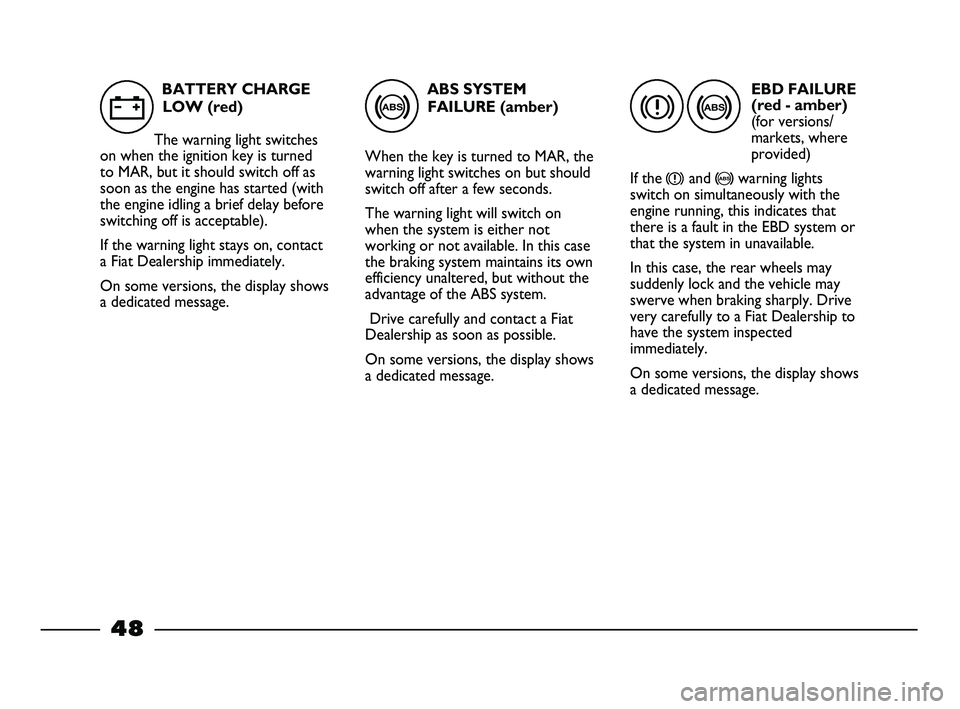
ABS SYSTEM
FAILURE (amber)
When the key is turned to MAR, the
warning light switches on but should
switch off after a few seconds.
The warning light will switch on
when the system is either not
working or not available. In this case
the braking system maintains its own
efficiency unaltered, but without the
advantage of the ABS system.
Drive carefully and contact a Fiat
Dealership as soon as possible.
On some versions, the display shows
a dedicated message. BATTERY CHARGE
LOW (red)
The warning light switches
on when the ignition key is turned
to MAR, but it should switch off as
soon as the engine has started (with
the engine idling a brief delay before
switching off is acceptable).
If the warning light stays on, contact
a Fiat Dealership immediately.
On some versions, the display shows
a dedicated message.
w>x>
EBD FAILURE
(red - amber)
(for versions/
markets, where
provided)
If the
xand >warning lights
switch on simultaneously with the
engine running, this indicates that
there is a fault in the EBD system or
that the system in unavailable.
In this case, the rear wheels may
suddenly lock and the vehicle may
swerve when braking sharply. Drive
very carefully to a Fiat Dealership to
have the system inspected
immediately.
On some versions, the display shows
a dedicated message.
48
045-094 STRADA LUM GB 1ed 23-01-2012 9:10 Pagina 48
Page 82 of 187
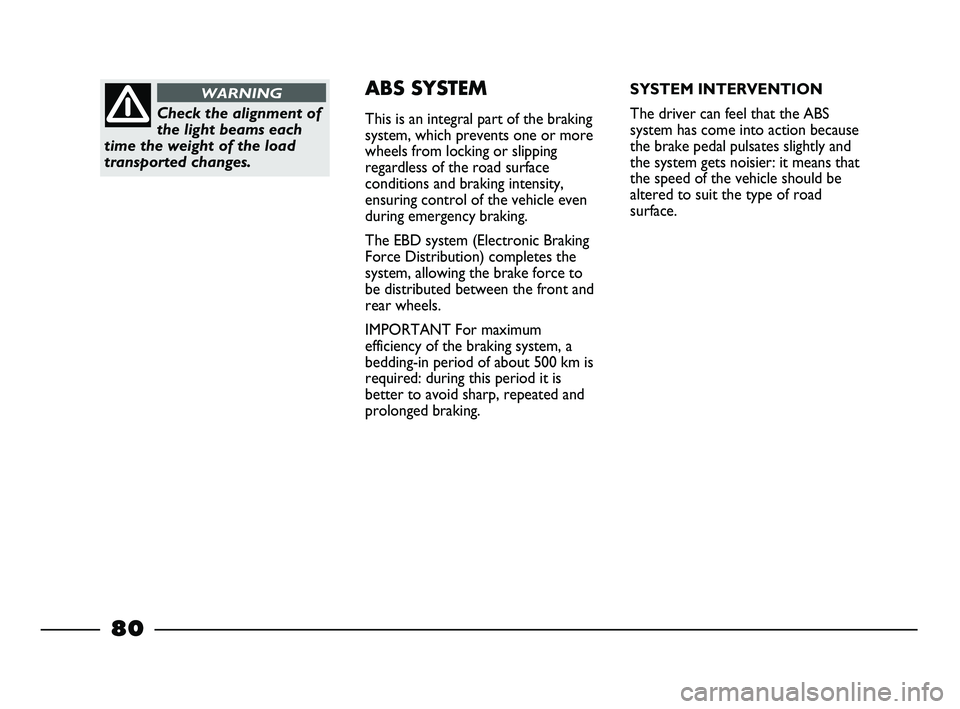
Check the alignment of
the light beams each
time the weight of the load
transported changes.
WARNINGABS SYSTEM
This is an integral part of the braking
system, which prevents one or more
wheels from locking or slipping
regardless of the road surface
conditions and braking intensity,
ensuring control of the vehicle even
during emergency braking.
The EBD system (Electronic Braking
Force Distribution) completes the
system, allowing the brake force to
be distributed between the front and
rear wheels.
IMPORTANT For maximum
efficiency of the braking system, a
bedding-in period of about 500 km is
required: during this period it is
better to avoid sharp, repeated and
prolonged braking.SYSTEM INTERVENTION
The driver can feel that the ABS
system has come into action because
the brake pedal pulsates slightly and
the system gets noisier: it means that
the speed of the vehicle should be
altered to suit the type of road
surface.
80
045-094 STRADA LUM GB 1ed 23-01-2012 9:10 Pagina 80
Page 83 of 187
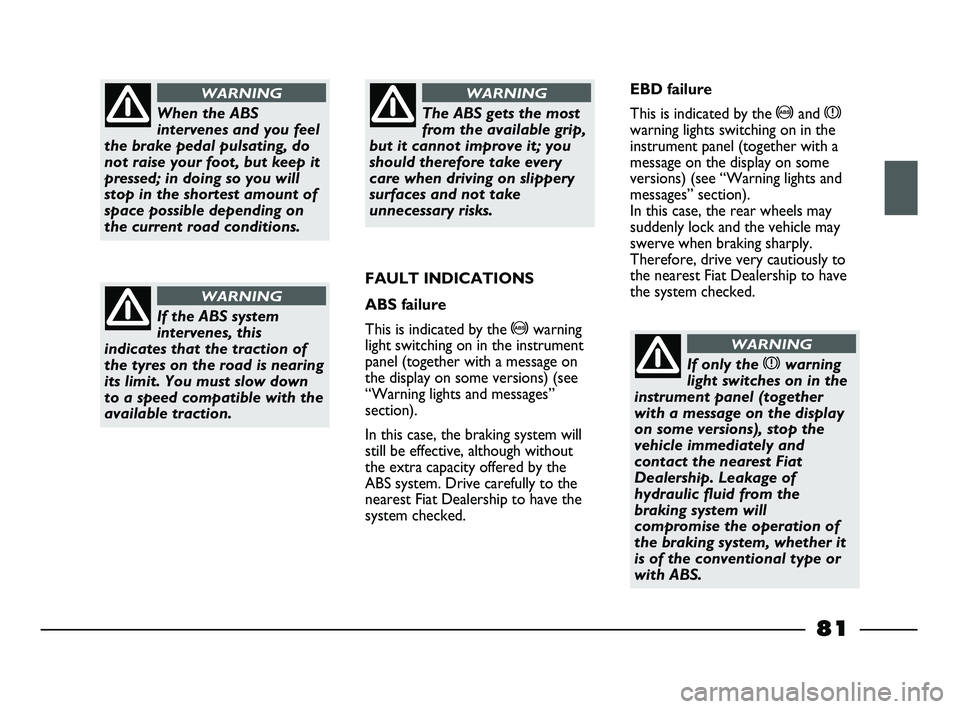
When the ABS
intervenes and you feel
the brake pedal pulsating, do
not raise your foot, but keep it
pressed; in doing so you will
stop in the shortest amount of
space possible depending on
the current road conditions.
WARNING
If the ABS system
intervenes, this
indicates that the traction of
the tyres on the road is nearing
its limit. You must slow down
to a speed compatible with the
available traction.
WARNING
The ABS gets the most
from the available grip,
but it cannot improve it; you
should therefore take every
care when driving on slippery
surfaces and not take
unnecessary risks.
WARNING
FAULT INDICATIONS
ABS failure
This is indicated by the >warning
light switching on in the instrument
panel (together with a message on
the display on some versions) (see
“Warning lights and messages”
section).
In this case, the braking system will
still be effective, although without
the extra capacity offered by the
ABS system. Drive carefully to the
nearest Fiat Dealership to have the
system checked. EBD failure
This is indicated by the >and x
warning lights switching on in the
instrument panel (together with a
message on the display on some
versions) (see “Warning lights and
messages” section).
In this case, the rear wheels may
suddenly lock and the vehicle may
swerve when braking sharply.
Therefore, drive very cautiously to
the nearest Fiat Dealership to have
the system checked.
If only the xwarning
light switches on in the
instrument panel (together
with a message on the display
on some versions), stop the
vehicle immediately and
contact the nearest Fiat
Dealership. Leakage of
hydraulic fluid from the
braking system will
compromise the operation of
the braking system, whether it
is of the conventional type or
with ABS.
WARNING
81
045-094 STRADA LUM GB 1ed 23-01-2012 9:10 Pagina 81
Page 86 of 187
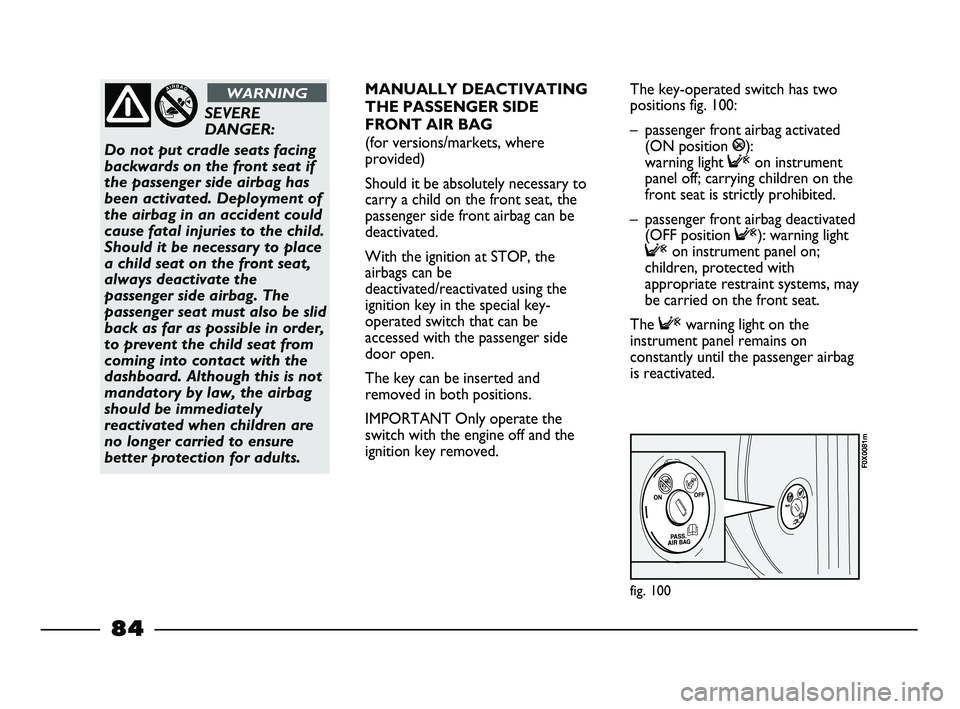
fig. 100
F0X0081m
SEVERE
DANGER:
Do not put cradle seats facing
backwards on the front seat if
the passenger side airbag has
been activated. Deployment of
the airbag in an accident could
cause fatal injuries to the child.
Should it be necessary to place
a child seat on the front seat,
always deactivate the
passenger side airbag. The
passenger seat must also be slid
back as far as possible in order,
to prevent the child seat from
coming into contact with the
dashboard. Although this is not
mandatory by law, the airbag
should be immediately
reactivated when children are
no longer carried to ensure
better protection for adults.
WARNINGMANUALLY DEACTIVATING
THE PASSENGER SIDE
FRONT AIR BAG
(for versions/markets, where
provided)
Should it be absolutely necessary to
carry a child on the front seat, the
passenger side front airbag can be
deactivated.
With the ignition at STOP, the
airbags can be
deactivated/reactivated using the
ignition key in the special key-
operated switch that can be
accessed with the passenger side
door open.
The key can be inserted and
removed in both positions.
IMPORTANT Only operate the
switch with the engine off and the
ignition key removed.The key-operated switch has two
positions fig. 100:
– passenger front airbag activated
(ON position
P):
warning light
Fon instrument
panel off; carrying children on the
front seat is strictly prohibited.
– passenger front airbag deactivated
(OFF position
F): warning light
Fon instrument panel on;
children, protected with
appropriate restraint systems, may
be carried on the front seat.
The
Fwarning light on the
instrument panel remains on
constantly until the passenger airbag
is reactivated.
84
045-094 STRADA LUM GB 1ed 23-01-2012 9:10 Pagina 84
Page 92 of 187
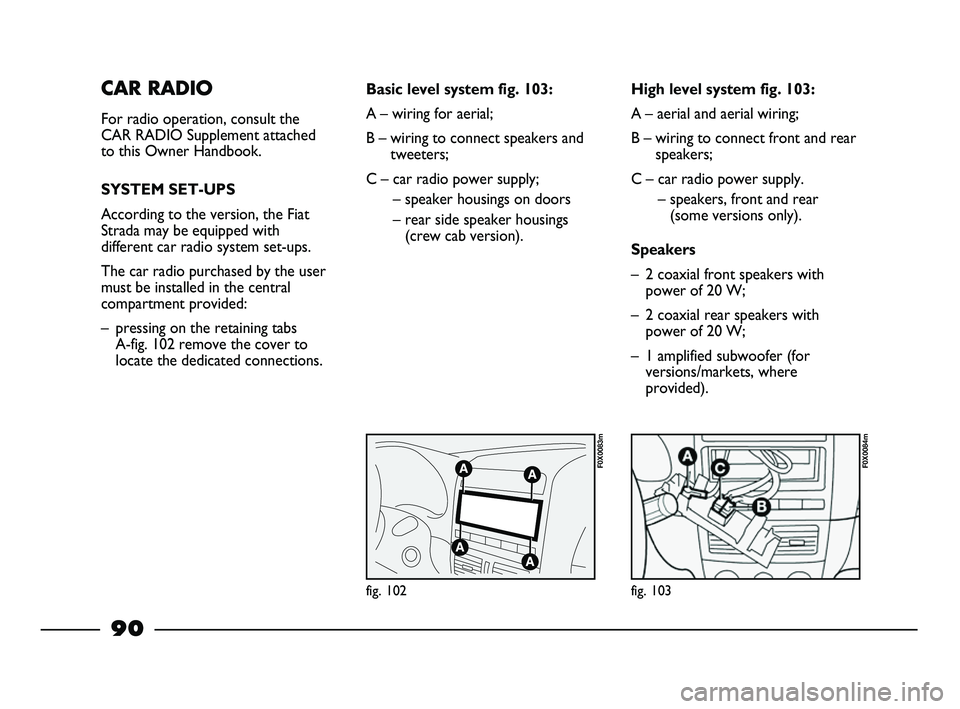
CAR RADIO
For radio operation, consult the
CAR RADIO Supplement attached
to this Owner Handbook.
SYSTEM SET-UPS
According to the version, the Fiat
Strada may be equipped with
different car radio system set-ups.
The car radio purchased by the user
must be installed in the central
compartment provided:
– pressing on the retaining tabs
A-fig. 102 remove the cover to
locate the dedicated connections.
fig. 102
F0X0083m
fig. 103
F0X0084m
Basic level system fig. 103:
A – wiring for aerial;
B – wiring to connect speakers and
tweeters;
C – car radio power supply;
– speaker housings on doors
– rear side speaker housings
(crew cab version).High level system fig. 103:
A – aerial and aerial wiring;
B – wiring to connect front and rear
speakers;
C – car radio power supply.
– speakers, front and rear
(some versions only).
Speakers
– 2 coaxial front speakers with
power of 20 W;
– 2 coaxial rear speakers with
power of 20 W;
– 1 amplified subwoofer (for
versions/markets, where
provided).
90
045-094 STRADA LUM GB 1ed 23-01-2012 9:10 Pagina 90
Page 99 of 187
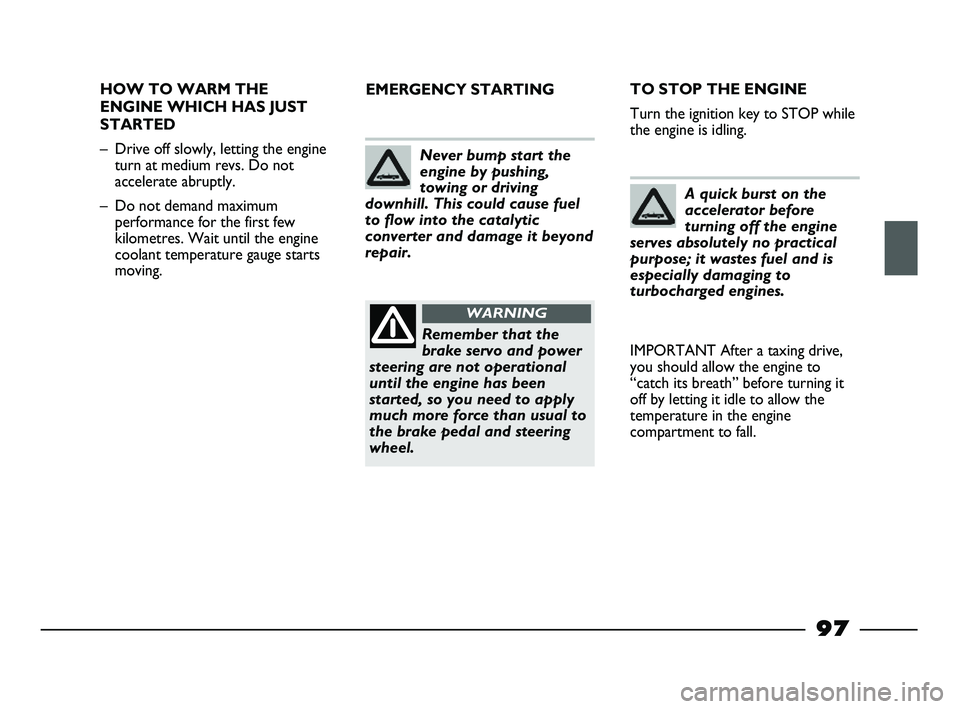
97
HOW TO WARM THE
ENGINE WHICH HAS JUST
STARTED
– Drive off slowly, letting the engine
turn at medium revs. Do not
accelerate abruptly.
– Do not demand maximum
performance for the first few
kilometres. Wait until the engine
coolant temperature gauge starts
moving.EMERGENCY STARTING
Never bump start the
engine by pushing,
towing or driving
downhill. This could cause fuel
to flow into the catalytic
converter and damage it beyond
repair.
Remember that the
brake servo and power
steering are not operational
until the engine has been
started, so you need to apply
much more force than usual to
the brake pedal and steering
wheel.
WARNING
TO STOP THE ENGINE
Turn the ignition key to STOP while
the engine is idling.
A quick burst on the
accelerator before
turning off the engine
serves absolutely no practical
purpose; it wastes fuel and is
especially damaging to
turbocharged engines.
IMPORTANT After a taxing drive,
you should allow the engine to
“catch its breath” before turning it
off by letting it idle to allow the
temperature in the engine
compartment to fall.
095-106 STRADA LUM GB 1ed 9-01-2012 14:51 Pagina 97
Page 105 of 187
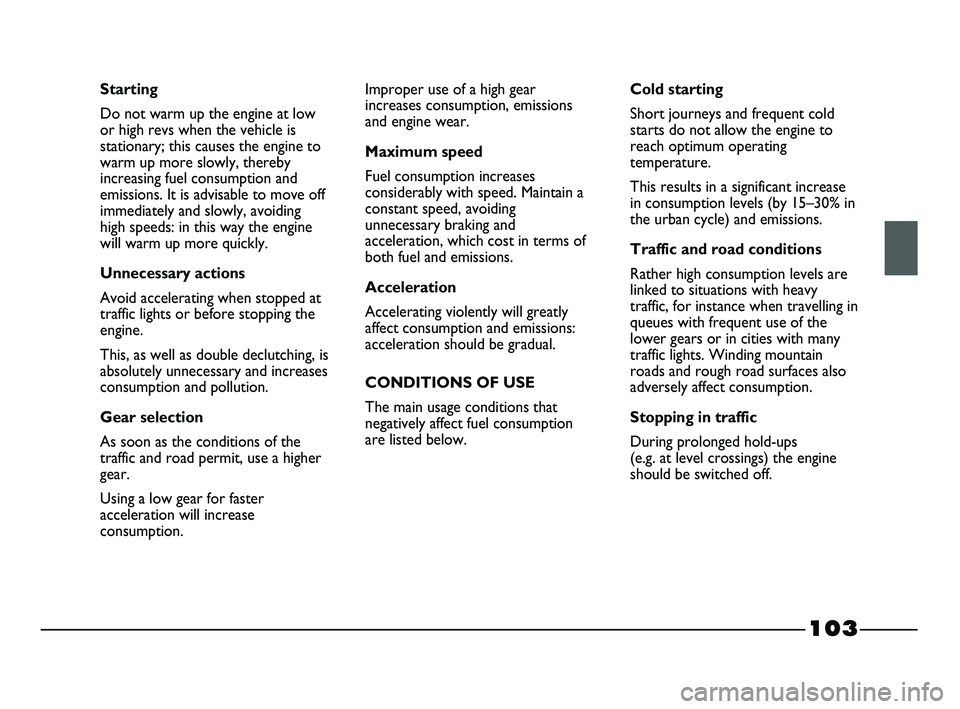
103
Starting
Do not warm up the engine at low
or high revs when the vehicle is
stationary; this causes the engine to
warm up more slowly, thereby
increasing fuel consumption and
emissions. It is advisable to move off
immediately and slowly, avoiding
high speeds: in this way the engine
will warm up more quickly.
Unnecessary actions
Avoid accelerating when stopped at
traffic lights or before stopping the
engine.
This, as well as double declutching, is
absolutely unnecessary and increases
consumption and pollution.
Gear selection
As soon as the conditions of the
traffic and road permit, use a higher
gear.
Using a low gear for faster
acceleration will increase
consumption.Improper use of a high gear
increases consumption, emissions
and engine wear.
Maximum speed
Fuel consumption increases
considerably with speed. Maintain a
constant speed, avoiding
unnecessary braking and
acceleration, which cost in terms of
both fuel and emissions.
Acceleration
Accelerating violently will greatly
affect consumption and emissions:
acceleration should be gradual.
CONDITIONS OF USE
The main usage conditions that
negatively affect fuel consumption
are listed below.Cold starting
Short journeys and frequent cold
starts do not allow the engine to
reach optimum operating
temperature.
This results in a significant increase
in consumption levels (by 15–30% in
the urban cycle) and emissions.
Traffic and road conditions
Rather high consumption levels are
linked to situations with heavy
traffic, for instance when travelling in
queues with frequent use of the
lower gears or in cities with many
traffic lights. Winding mountain
roads and rough road surfaces also
adversely affect consumption.
Stopping in traffic
During prolonged hold-ups
(e.g. at level crossings) the engine
should be switched off.
095-106 STRADA LUM GB 1ed 9-01-2012 14:51 Pagina 103
Page 106 of 187
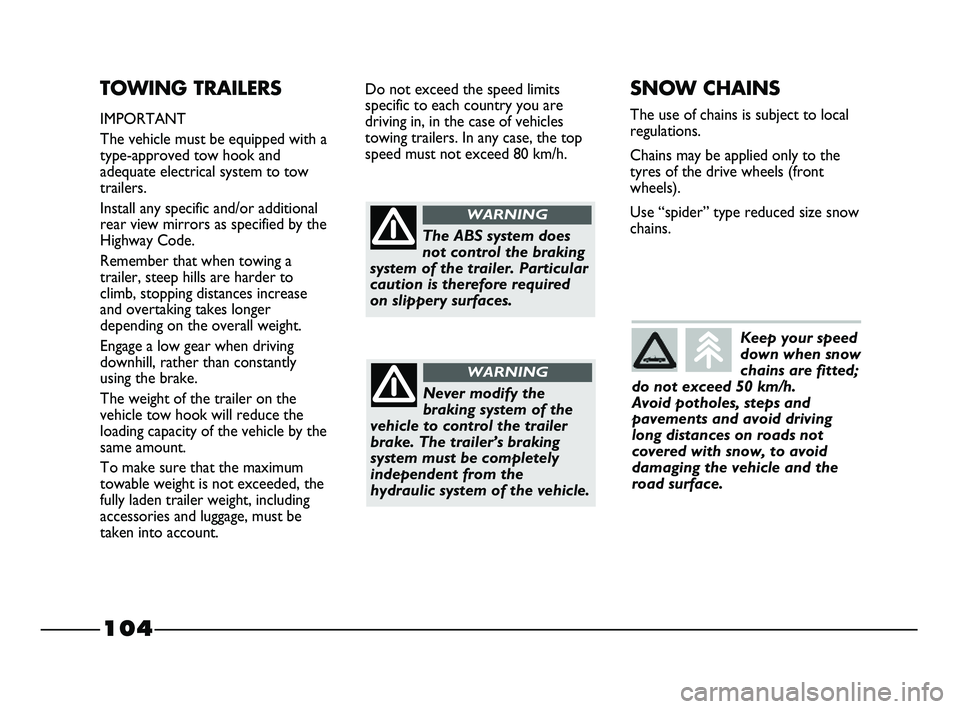
104
TOWING TRAILERS
IMPORTANT
The vehicle must be equipped with a
type-approved tow hook and
adequate electrical system to tow
trailers.
Install any specific and/or additional
rear view mirrors as specified by the
Highway Code.
Remember that when towing a
trailer, steep hills are harder to
climb, stopping distances increase
and overtaking takes longer
depending on the overall weight.
Engage a low gear when driving
downhill, rather than constantly
using the brake.
The weight of the trailer on the
vehicle tow hook will reduce the
loading capacity of the vehicle by the
same amount.
To make sure that the maximum
towable weight is not exceeded, the
fully laden trailer weight, including
accessories and luggage, must be
taken into account.Do not exceed the speed limits
specific to each country you are
driving in, in the case of vehicles
towing trailers. In any case, the top
speed must not exceed 80 km/h.
The ABS system does
not control the braking
system of the trailer. Particular
caution is therefore required
on slippery surfaces.
WARNING
Never modify the
braking system of the
vehicle to control the trailer
brake. The trailer’s braking
system must be completely
independent from the
hydraulic system of the vehicle.
WARNING
SNOW CHAINS
The use of chains is subject to local
regulations.
Chains may be applied only to the
tyres of the drive wheels (front
wheels).
Use “spider” type reduced size snow
chains.
Keep your speed
down when snow
chains are fitted;
do not exceed 50 km/h.
Avoid potholes, steps and
pavements and avoid driving
long distances on roads not
covered with snow, to avoid
damaging the vehicle and the
road surface.
095-106 STRADA LUM GB 1ed 9-01-2012 14:51 Pagina 104
Page 115 of 187
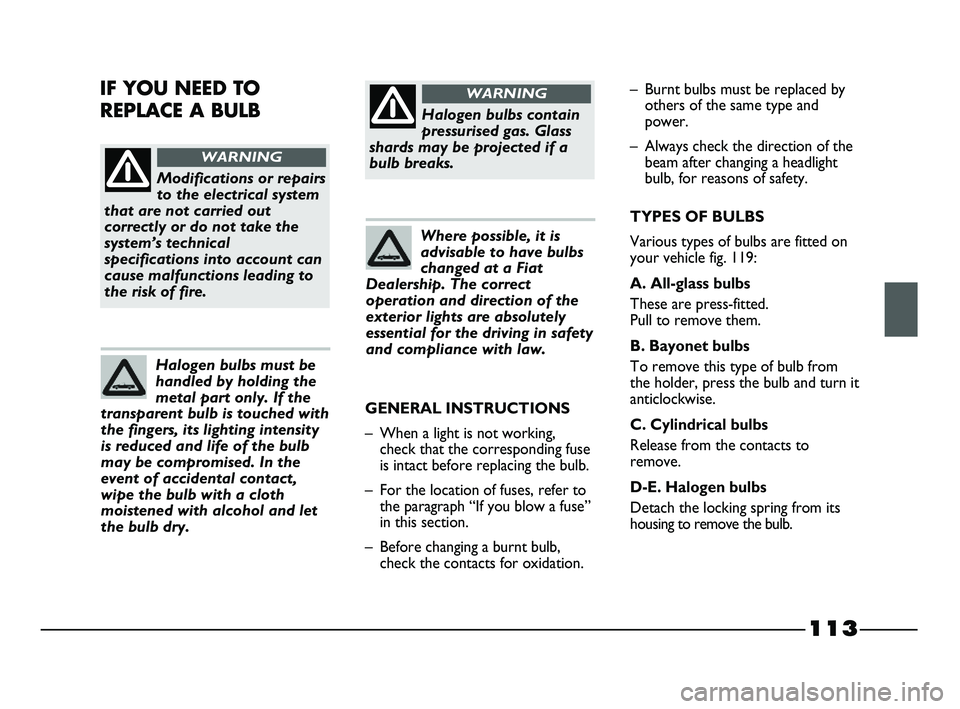
113
Modifications or repairs
to the electrical system
that are not carried out
correctly or do not take the
system’s technical
specifications into account can
cause malfunctions leading to
the risk of fire.
WARNING
Halogen bulbs contain
pressurised gas. Glass
shards may be projected if a
bulb breaks.
WARNING
Halogen bulbs must be
handled by holding the
metal part only. If the
transparent bulb is touched with
the fingers, its lighting intensity
is reduced and life of the bulb
may be compromised. In the
event of accidental contact,
wipe the bulb with a cloth
moistened with alcohol and let
the bulb dry.
Where possible, it is
advisable to have bulbs
changed at a Fiat
Dealership. The correct
operation and direction of the
exterior lights are absolutely
essential for the driving in safety
and compliance with law.
– Burnt bulbs must be replaced by
others of the same type and
power.
– Always check the direction of the
beam after changing a headlight
bulb, for reasons of safety.
TYPES OF BULBS
Various types of bulbs are fitted on
your vehicle fig. 119:
A. All-glass bulbs
These are press-fitted.
Pull to remove them.
B. Bayonet bulbs
To remove this type of bulb from
the holder, press the bulb and turn it
anticlockwise.
C. Cylindrical bulbs
Release from the contacts to
remove.
D-E. Halogen bulbs
Detach the locking spring from its
housing to remove the bulb.IF YOU NEED TO
REPLACE A BULB
GENERAL INSTRUCTIONS
– When a light is not working,
check that the corresponding fuse
is intact before replacing the bulb.
– For the location of fuses, refer to
the paragraph “If you blow a fuse”
in this section.
– Before changing a burnt bulb,
check the contacts for oxidation.
107-132 STRADA LUM GB 1ed 9-01-2012 14:52 Pagina 113